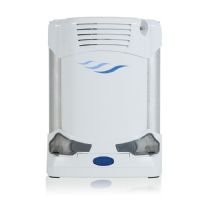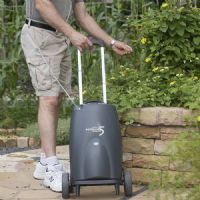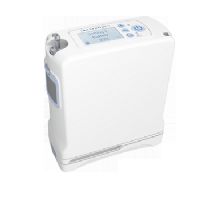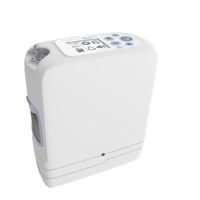 Written by Amanda Lundberg, BSN, RN
Written by Amanda Lundberg, BSN, RN
Every cell in your body needs a constant supply of oxygen to function. Taken in through the air into the lungs, oxygen is passed on to your bloodstream and delivered to your cells. But when you have COPD, COVID-19, emphysema, sleep apnea, or other breathing issues, the amount of oxygen your lungs are able to naturally take in can be compromised, which can be detrimental to organ function. Lacking sufficient oxygen can damage organs, so a portable oxygen concentrator (POC) can truly be a lifesaver. The benefits of supplemental oxygen therapy that make a big impact on your quality of life include less fatigue and shortness of breath and better sleep. A form of oxygen therapy, POCs convert oxygen from ambient air. By filtering and compressing air, a concentrated form of oxygen is delivered to the user.
Although being prescribed oxygen therapy either for temporary or long-term use can be overwhelming, you're not alone. It’s estimated that 1.5 million people in the U.S. use supplemental oxygen therapy to support healthy organ function. A portable oxygen concentrator doesn’t have tanks that need to be refilled and is more cost-effective than compressed gas cylinders. A portable oxygen concentrator can be used “on the go” with a battery pack, supporting a more active lifestyle.
6. Best for Seniors: Freestyle Comfort Portable Oxygen Concentrator with UltraSense
5. Best For Travel: X-PLOR Portable Oxygen Concentrator by Belluscura
4. Best Dual Portable and Stationary: SeQual Eclipse 5 Portable Oxygen Concentrator
3. Best for Remote Patient Monitoring: Portable Oxygen Concentrator Oxlife Freedom by O2 Concepts
2. Best Ultralightweight: Inogen One G4 Portable Oxygen Concentrator
1. Best All Around: G5 Portable Oxygen Concentrator by Inogen 6LPM
Lightweight compact models of portable oxygen concentrators are helpful for users with breathing issues who need supplemental oxygen away from home. Small and quiet, they work similarly to stationary models by extracting oxygen from the surrounding air and converting it into condensed oxygen, but they allow for a more active lifestyle. They can significantly add to a user’s quality of life by allowing them to enjoy activities away from home. Compact models with carry bags, extended-life batteries, AC/DC chargers, or backpacks that maximize portability and are FAA-compliant for plane travel provide the most options for travel.
Flow settings control the intermittent fixed volume of oxygen when the system is triggered by the user inhaling. Most portable oxygen concentrators have four to six settings, but they can go as high as 9. If you need a higher volume of oxygen as prescribed by your doctor, be sure the model you choose has an output to match your needs. Measured in liters per minute, the flow rate (not to be confused with pulse dose settings) is the rate at which oxygen is able to travel from the device to the user, and is one of the most important factors to consider when buying an oxygen concentrator.
How and when you need oxygen will help you decide whether a continuous flow or pulse dose model is best for you. With continuous flow, oxygen is delivered at a regular continuous rate, while pulse flow delivers the oxygen via a specific setting based on the user’s breath rate. Pulse dose models expel oxygen to the user as he or she inhales, and is usually sufficient for most people who use supplemental oxygen. Some models provide both options for oxygen delivery.
Bluetooth compatibility allows the user, and any caregivers, to use a smartphone or tablet to connect to the portable oxygen concentrator to monitor performance metrics and treatment values, and make adjustments quickly and easily based on the information provided in the app.
Because purchasing a portable oxygen concentrator for home use is a significant investment, you’ll appreciate a solid manufacturer’s warranty. If a company will stand by its equipment, you can enjoy peace of mind knowing they believe it will hold up under constant use for a long time, and that if it doesn’t, they’ll replace or repair it.
Battery life for most of the smaller POCs can be expected to range between two and five hours, depending on the settings. Because portability is greatly impacted by the device being available for use while on the go, longer use-time between charges allows you to be as active as possible without worrying about having to cut an activity short so you can charge your oxygen concentrator. Some models have different battery options you can choose from that extends the use time. If you don’t want to be stuck waiting for your POC to charge, models that charge more quickly, or allow you to use them while they’re charging, also free you up to be away from home more.
POCs absorb nitrogen and produce 90 to 95 percent pure oxygen from room air. Generally, portable oxygen concentrators produce between two and five liters per minute. When making a purchasing decision, make sure the POC you choose meets the parameters of your doctor’s oxygen support prescription.
Having extra batteries, battery chargers, and AC or DC power supplies on hand will help ensure you always have supplemental oxygen available when you’re out and about. Carrying cases come in several designs, from over-the-shoulder to rolling to backpack styles so you can comfortably take your POC along wherever you need to be.
 | Freestyle Comfort Portable Oxygen Concentrator with UltraSense View Product |
The compact Freestyle Comfort Portable Oxygen Concentrator with UltraSense from CAIRE Medical connects wirelessly to your smartphone. You can view and track data, and automatically adjust this POC’s oxygen output in real time. Its highly sensitive breath detection system delivers sufficient oxygen to meet your precise needs. With five settings, it provides up to 1,050 mL of oxygen per minute.
With age, the respiratory system undergoes various changes that can impede lung function. Aging can also impact strength, posture, balance, and cognition, and this POC weighs less than five pounds and has a specially designed ergonomic curved shape to make it more comfortably portable.
The easy-to-read control panel has a full-color display and handy access that doesn’t require taking this powerful portable oxygen concentrator out of its carrying case. It comes with an 8-cell battery lasting four hours, or a 16-cell battery that lasts up to eight hours.
 | SeQual Eclipse 5 Portable Oxygen Concentrator View Product |
Offering both pulse flow and continuous flow oxygen delivery settings, the powerful SeQual Eclipse 5 POC from CAIRE Medical is a great option for an oxygen concentrator for home use while stationary or while traveling.
It has a maximum output of 3,000 mL per minute of continuous flow oxygen and up to 192 mL for a pulse dose therapy bolus, and uses AutoSAT technology to provide a consistent amount of oxygen even with changes in breath rate.
The mobile wheeled cart has two casters and a telescoping handle to make transport easier, so it can be rolled or carried wherever you need to be. It’s FAA-approved for flights, and if you charge it in your vehicle while driving, it can still be used while charging on DC power. The SeQual Eclipse 5 is powered by an updated motor that provides higher levels of oxygen than previous models, but it’s still quiet.
The X-PLOR Portable Oxygen Concentrator by Belluscura supports an active lifestyle and is small enough to go wherever you want to go. With an oxygen output of 82-92 percent purity, it rivals the output of bulkier and more cumbersome stationary concentrators. Its proprietary technology delivers oxygen more efficiently than standard portable oxygen concentrators for home use.
With Bluetooth connectivity, the Nomad Biometrics app tracks a multitude of real-time metrics including battery life, oxygen purity, alarm history, and battery cycle. It has four adjustable pulse flow settings, including an extra boost for 10 minutes if needed. It can detect breath rate, and No Breath Detected Mode ensures three continuous minutes of oxygen flowing at 750 mL per minute. Another benefit of this model is the patented ModulAir technology, which allows users to replace their own sieves.
At just eight inches tall, this user-friendly POC can fit in a compact over-the-shoulder carrying case. Since it's FAA-compliant, you can count on oxygen delivery while you’re traveling by plane.
The battery lasts up to 4 ½ hours, with an auto-off function to save battery life when it is idle for more than three minutes.
The Oxlife Freedom Portable Oxygen Concentrator from O2 Concepts is a lightweight, more compact version of the Oxlife Independence, delivering a premium oxygen supply anywhere you need it. The battery takes just two hours to fully charge on either AC or DC power, and provides more than four hours of operation. Additionally, this portable oxygen concentrator can be used while it’s charging.
It has an easy-to-read simple user interface with a full-color LCD display that allows you to see the battery level and pulse settings, including the level of oxygen delivered per breath. It’s easy to make adjustments as needed. The manufacturer remains connected to the device, monitoring its operation to ensure an uninterrupted oxygen supply. This POC provides more than three times the available flow of other leading models.
The LCD full-color screen very clearly displays the battery level, which pulse setting you've chosen, and the level of oxygen delivered per breath on that setting. Simple plus/minus buttons on the right side allow you to adjust your pulse setting; with the M menu button, users can navigate through a variety of settings including airplane mode and an internal alarm.
The Oxlife Freedom Includes:
 | Inogen One G4 Portable Oxygen Concentrator View Product |
Weighing less than three pounds, the Inogen One G4 Portable Oxygen Concentrator is one of the smallest, lightest designs available. Compact and extremely quiet, it allows for easy transport via the included carrying bag and strap. The enhanced portability helps users maintain a more active daily lifestyle around the house or while traveling.
Unlike the continuous oxygen flow delivered by most oxygen tanks and concentrators, the Inogen One G4 has an Intelligent Oxygen Delivery System, which only expels oxygen while the user inhales, delivering oxygen in 1-3 flow settings. You have the option of a 4-cell battery that provides 2.7 hours of use between charges, and an 8-cell battery that provides up to 5 hours of use per charge. It also comes with an AC/DC power cable to charge it at home or in the car.
The Inogen Connect Bluetooth app connects wirelessly to the unit, allowing you to check the battery life, monitor column life status and reset when replacing columns, easy access to FAQs and troubleshooting tips, and software updates to ensure optimal performance.
 | Inogen One G5 Portable Oxygen Concentrator View Product |
The G5 Portable Oxygen Concentrator by Inogen is specifically designed to deliver the correct dose of oxygen whether the user is active, resting, or sleeping. This portable oxygen concentrator is meant to be used for long periods of time and comes with your choice of batteries. The 8-cell battery delivers up to 6-½ hours of use and the 16-cell battery provides 13 hours of use. This portable oxygen concentrator also comes with AC and DC power cables so you always have access to a dependable oxygen supply.
This unit is highly portable, with a lightweight compact design and a carrying case for use away from home. This supports users who value their independence and don’t want to be stuck at home just because they need oxygen therapy. It’s unobtrusive and super quiet, so you can be comfortable using it anywhere.
An accompanying Bluetooth app monitors this device, providing peace of mind and alerting you to any potential issues with its operation. Its LCD display is easy to read, and its push-button control is simple to operate. The six pulse-dose flow settings allow for customizable therapy, so you know you are getting the correct dose of oxygen for maximum benefit.
The 8-cell system weighs less than 5 pounds, and the 16-cell system weighs less than 6 pounds, and it’s been approved by the FAA for use on airplanes making traveling with the G5 Portable Oxygen Concentrator a breeze. This version has all the benefits and functions of the earlier single-battery G3 model, but with the added option of either an 8-cell or 16-cell battery pack.
We reviewed many portable oxygen concentrators and the G5 Portable Oxygen Concentrator by Inogen is our top pick. We like it because it’s lightweight, extremely quiet, easy to travel with, has a dedicated Bluetooth app, and supports the freedom and independence that come from being able to travel with it.
No, there is no such thing as becoming "dependent on" or "addicted to" supplemental oxygen. If the 21 percent oxygen in the air is not sufficient to maintain appropriate oxygen levels in your bloodstream, oxygen therapy merely gets your blood oxygenated to the optimal level. Since you need a constant supply of oxygen to live, you need it to keep your cells - and all the tissues and organs made up by those cells - oxygenated to the appropriate level to be healthy and function correctly.
Yes, many portable oxygen concentrators for home use are designed for 24-hour-a-day use, during all phases of activity and sleep. In fact, since your breathing often slows while you’re sleeping, using a POC will help maintain healthy oxygen levels when you’re asleep.
Pulse dose is based on breathing and inhaling, with the oxygen therapy delivered according to breath rate. Continuous flow delivers oxygen at a constant rate no matter what the user’s breath rate is.
The key differences include oxygen output, size and weight, power options, and cost. Portable oxygen concentrators are smaller and weigh less, plus provide more flexibility for power options. They usually rely on lithium-ion batteries, which can be recharged about 300 times before they start to degrade. Their portability makes them the best choice for users who are often away from electrical wall outlets. Stationary oxygen concentrators for home use generally have higher oxygen outputs along with lower costs. However, they can severely limit mobility, keeping users who need to be on continuous oxygen very close to home.
Portable Oxygen Concentrators can run non-stop while plugged into electrical outlets. Depending on the model, a battery charge can range from 1 to 11 hours on internal batteries (longer with external backup batteries).
Proper oxygenation is necessary to support optimal health. When supplemental oxygen therapy is prescribed, the user benefits from more energy, better sleep, easier breathing, and higher quality of life. No longer tied to using an oxygen tank, users can turn to a portable oxygen concentrator to provide extra oxygen conveniently and on the go.
For more useful information on equipment and devices that support health and well-being, including product reviews and buyer’s guides, visit Caregiver University.

Amanda is a registered nurse with over a decade of experience in hospital, clinic, and healthcare management settings. Her primary focus has been collaborating with patients to manage disease processes. Aiming at continuing active lifestyles for her patients, Amanda has become an expert in adjunct therapies.
Amanda incorporates a holistic approach to heal the body from within. She has completed extensive research in remedial treatments using oxygen, as well as becoming a professional light therapy specialist. Her reparative ethos to health has sparked engaging conversations and teaching opportunities nationwide.
Amanda has taken her passion for articulating technical medical language and transitioned to freelance writing. She enjoys bringing a clinical voice to health and wellness brands.